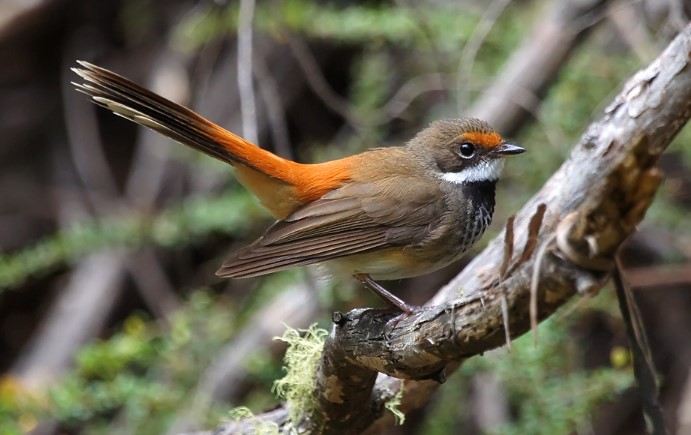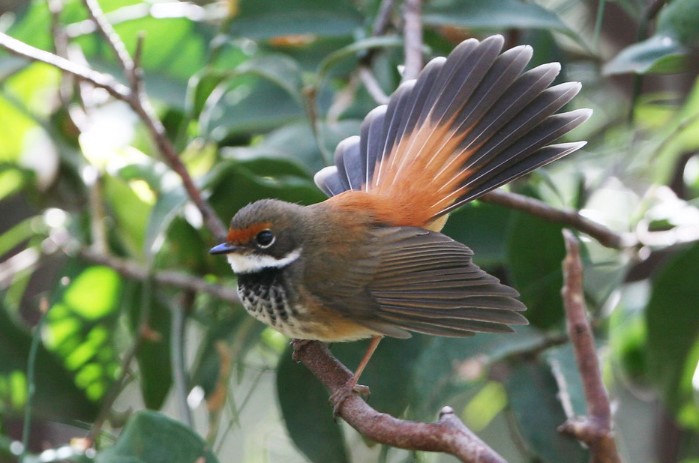Rufous Fantail (Rhipidura rufifrons) slight form and slow fluttering flight make it well-suited to hawking in close shrubbery, but the bird ranges widely throughout the southwestern Pacific and migrates north to winter in northeastern Queensland and southern New Guinea in March-April, and then back to breed in September-October in southeastern Australia.
During migration, migrants travel alone, flitting from shrub to shrub and picking up food during the twilight hours. In Australia, Rufous Fantails come in two distinct races that are potentially good species. These sedentary birds inhabit mangroves and fringed vine scrubs around the north coast; they have long, gray tails with broad white tips.
A second species lives in rainforests and sclerophyll forests along the east coast and adjacent ranges with a shorter, duskier tail and a broad rufous back; the movements of this species are more complex. While it breeds north almost to Cooktown, only populations south of 25°S seem to be strictly migrants; breeding populations further north may be little more than local nomads, only shifting from mountains to warmer coasts in winter.

Foraging occurs in shrubby substages of forest within a meter or two of the ground, wherever Rufous Fantails occur. From one perch to another, they continuously launch out in short, soaring flights, raising their continuously fanned tails vertically for takeoff and tumbling, diving, twisting, and looping among close foliage. There is little food to be found in foliage, nor is there much to be found in open spaces.
Through their twisting and fanning, they dislodge or flush sedentary insects such as beetles, bugs, weevils, mites, and spiders. Like all fantails, they choose thick branchlets to perch on so that they can focus on prey while flying. Deep shrubby glades are the nesting grounds of Rufous Fantails. During nest building, incubation, and feeding, both sexes participate.
The brush cuckoo parasitizes them. It is common for them to feed on small insects in mixed-species feeding flocks. A variety of Passerine birds can be found among them, including spectacled monarchs, little shrikethrushes, large-billed scrubwrens, and less frequently, green-backed honeyeaters.
In addition to its common name, it is also known as the Rufous-fronted Fantail, the Wood Fantail, and the Rufous Flycatcher. Rufous fantails measure about 155–165 mm in length. Adults are similar in both sexes. On the lower back and base of the tail, the upper parts and wings become orange-to-dark rufous.
The tail’s terminal half is dusky or mid-grey with a grey or broadly white tip. The face is brown with rufous brows and a light under-eye ring. It has a white throat, a black band on the lower throat, and a white feather edge around the upper breast. The belly is white, and the flanks and undertail are buff. The lower mandible is paler than the upper mandible; it has a blackish-brown eye, bill, and feet.
Immature has an orange-rufous pattern over its upper parts; its face pattern is dull; its upper breast band is dull gray-brown; and the rest of its underparts are dirty rufous-buff. Several months after fledging, the adult plumage is moulted.
When at rest or in flight, Rufous Fantail calls with a single high-pitched squeaking chip. There’s a thin, tinny see-saw sequence of notes in Rufous Fantail’s song, similar to Grey Fantail’s, but descending and less rhythmically defined.
Breeding and nesting take place between late October and February. The nest consists of a neat, tailed cup 50mm across x 40mm deep with a 70mm tail. It is usually made up of fine grasses and small roots, bound tightly and smoothly with cobweb. Lined with soft plant fiber, the nest is usually located on a thin, horizontal fork of a shrub or tree, 1–10 meters above the ground.
It usually lays two eggs, but sometimes three, that are pale stone to buff in color with minute brown and lavender-grey spots on the larger end. The eggs are long-oval in shape, measuring 16 x 13 mm in size. There is an incubation period of 14–15 days for both sexes. It takes about 10–12 days for the young to fledge.
In wet forests and mangroves, the Rufous Fantail is primarily found in northern and eastern coastal Australia, from the Kimberleys of Western Australia to the southwest of Victoria. There are also many islands in the southwest Pacific. The number of races is about 20 to 30; however, only two races are found in Australia.
Read More: Willie Wagtail







